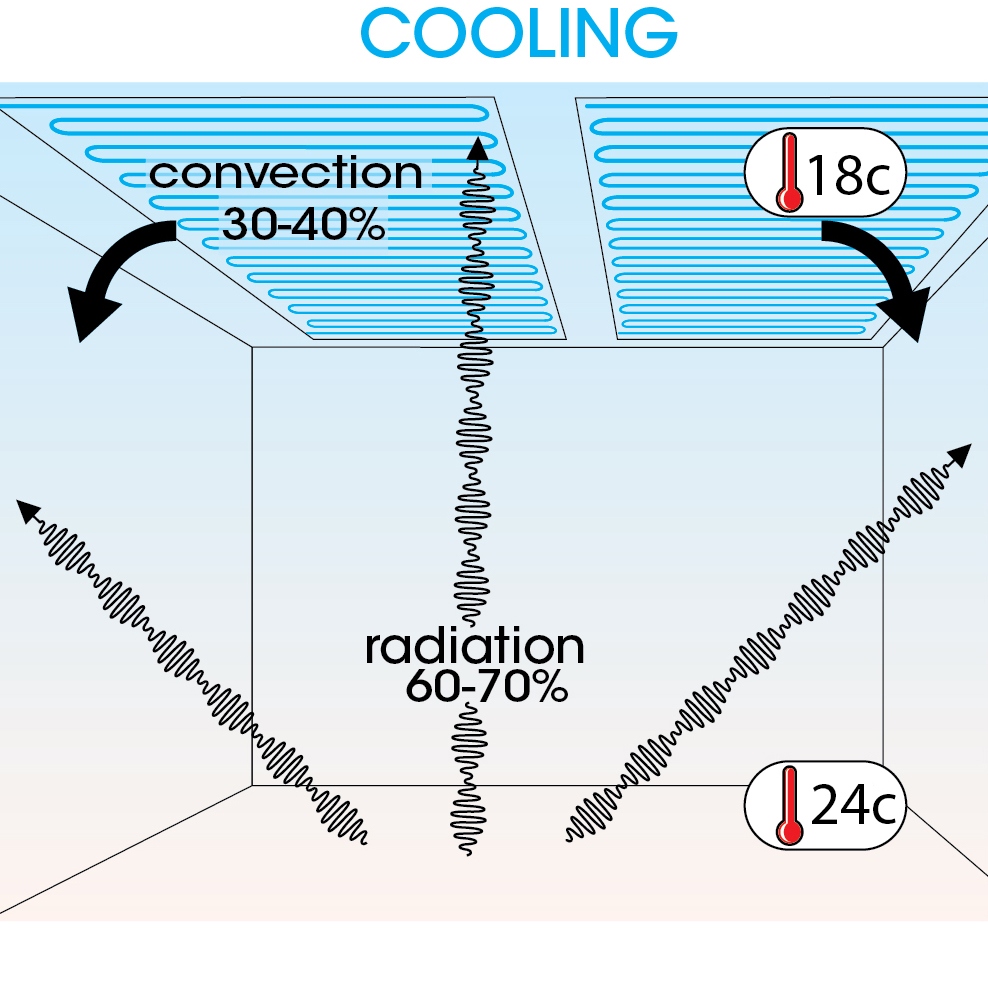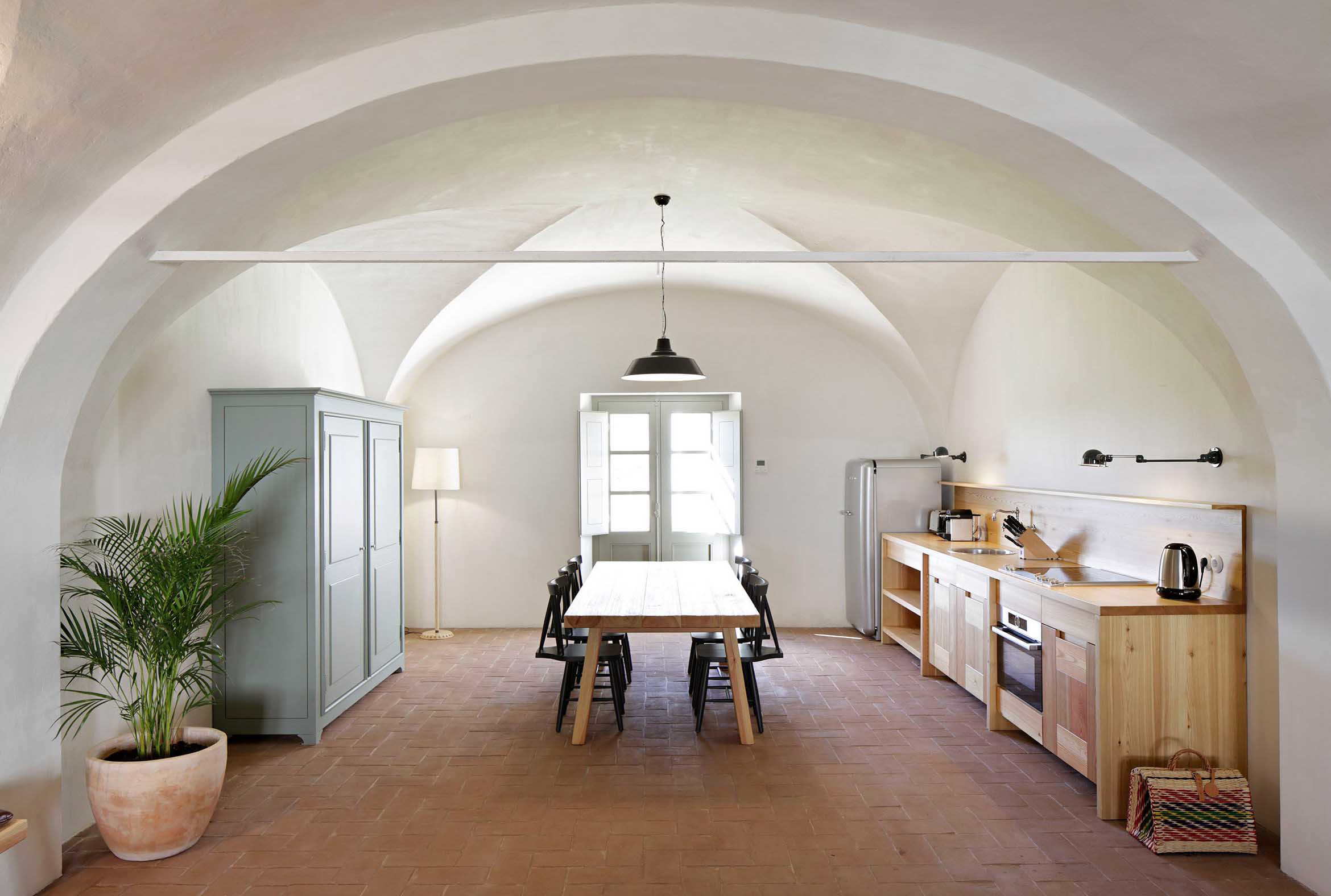
Air conditioning of your premises with radiant cold ceiling.
Radiant cold ceiling is an innovative technology that uses chilled water running through ceiling panels to absorb heat and cool a room. It operates silently, is energy-efficient, and provides precise temperature control. This new technology offers significant advantages over traditional air conditioning systems and is becoming increasingly popular in homes and businesses worldwide.
How does it work?

Radiant cold ceiling systems use chilled water running through pipes embedded in the ceiling panels to absorb heat and cool a room. The process of cooling is known as radiant cooling and works by absorbing the heat that radiates from the occupants and objects in the room.
The chilled water in the pipes is typically maintained at a temperature of around 16°C to 18°C (60°F to 64°F). As the warm air in the room comes into contact with the chilled ceiling panels, the heat is absorbed by the cool water running through the pipes. This absorption of heat causes the water temperature to rise slightly, and the warmer water is then sent back to the chiller, where it is cooled again and recirculated through the ceiling panels.
As the ceiling panels cool the room, the occupants’ bodies and objects in the room emit heat, which is absorbed by the ceiling panels. This process of absorption and emission continues, creating a comfortable and even temperature throughout the room.
The closed water cycle of the system enables its use with either gas or water chillers. You may use existing chiller unit from your traditional AC unit. The system is composed of several basic components, similar to those found in traditional radiator or underfloor heating systems:
- Capillary tube cooling mats
- Distribution unit (manifold, pump, pressure expansion tank)
- Chiller
- Heat exchanger (water to water or gas to water)
- Room temperature control

Quick Benefits compare to regular AC systems.

No Air Movement

Healthy Environment

Noise Reduction

Sustainable and Efficient

Maintenance-free

No Water Drain

Space Saving

Sleek Design
How does it look?
Capillary mats covered with plaster

Cold ceilings that are made of capillary tube mats offer a unique cooling solution with a minimal ceiling profile. These systems use small diameter tubes that are installed within the ceiling, resulting in a low profile design that is perfect for modern, minimalist architecture.

One of the key benefits of these systems is that they can be easily integrated into various ceiling designs, including arch ceilings, without spoiling the overall aesthetic. The small diameter tubes used in the system also allow for a higher degree of flexibility when it comes to the placement of the cooling system. This means that architects and designers can create more customized and innovative indoor spaces without having to compromise on comfort.

In addition to their sleek design, capillary tube mats offer energy efficiency and cost savings. The small diameter tubes require less energy to cool the same amount of space as traditional AC systems, resulting in lower energy bills and a reduced carbon footprint.

Overall, cold ceilings made of capillary tube mats offer a unique cooling solution that is perfect for modern and minimalist design aesthetics. Their small ceiling profile and energy efficiency make them an ideal choice for those who are looking to create a comfortable, sustainable, and visually appealing indoor environment.
Drywall (Plasterboard) prefabricated panels

The heat-conducting pipes in standard thermally activated drywall ceilings consist of BEKA capillary tube mats, which are located on the back of the drywall panels for good thermal conductivity and hydraulic connection in the ceiling cavity.
Our company also offers ready-to-build plasterboard with integrated capillary tubes or integrated 10 mm PE-RT tubes. We provide drywall panels with capillary tube mats and polystyrene insulation in standard dimensions as part of our prefabricated elements.
Additional insulation material can be added to the heat-carrying capillary tubes in the standard construction to improve the reaction speed of the ceiling heating and cooling.
Metal Cassette Ceiling with Capillary Tube Mats

We offers a solution that combines metal cassettes or ceiling panels with capillary tube technology for improved energy efficiency. The capillary tube mats, with a diameter of 3.35 mm and wall thickness of 0.5 mm, are spaced 10 mm apart, compensating for the low thermal conductivity of polypropylene and ensuring an even surface temperature. The mats can be inserted with millimeter precision into almost any format of the ceiling cassette, maximizing the thermally active surface of the ceiling.

Gluing the capillary tubes in the cassette is an advantage, but it must remain flexible to avoid reducing heat transfer from the cassette surface to the heat-conducting pipes. BEKA offers capillary tube mats manufactured with millimeter precision for the corresponding cassette format, which can be glued into the ceiling cassettes upon customer request, reducing sorting work on the construction site. Alternatively, the capillary tube mats can also be inserted into the ceiling cassettes on site by the construction team, which is especially useful for modernization projects.

Finally, the capillary tube mats are quickly and securely connected to each other and to the supply pipelines using flexible hoses and plug connector technology. The supply pipelines can also be prefabricated from polypropylene tubing with inserted plug-in couplings, simplifying the installation process even further. Overall, BEKA’s capillary tube technology provides a flexible and efficient option for heating and cooling in combination with metal cassettes or ceiling panels.
How does it perform?

The demand for comfortable indoor temperatures has never been greater. However, achieving the perfect balance of comfort and energy efficiency can be a challenge. That’s why it’s important to look to nature for inspiration. Radiant heat transfer is a natural phenomenon that can be harnessed to create a healthy and pleasant room climate.
By learning from nature, we can achieve the perfect indoor environment without sacrificing energy efficiency. Whether you’re cooling a living space, a commercial building, or an industrial facility, radiant heat transfer can help you achieve your goals. It’s an environmentally friendly technology that can help you reduce your carbon footprint while also saving you money on your energy bills.
So if you’re looking for a natural, energy-efficient solution to your indoor climate control needs, consider radiant heat transfer. It’s a proven technology that can help you achieve the perfect balance of comfort, health, and energy efficiency in your indoor environment.
Send request